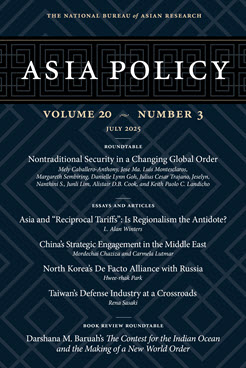Article in Asia Policy 20.3
China’s Strategic Engagement in the Middle East
Energy Security, Economic Integration, and Geopolitical Influence
This article explores China’s strategic objectives in the Middle East, underscoring its efforts to secure energy access, broaden its economic footprint, and challenge Western-dominated global governance by advancing a multipolar order.
EXECUTIVE SUMMARY
MAIN ARGUMENT
The Middle East figures prominently in China’s broader geopolitical vision, and Beijing’s approach is underpinned by a pragmatic, noninterventionist strategy without overt security responsibilities. Central to this strategy is the diversification of energy imports as a hedge against overdependence on traditional suppliers like Russia. Concurrently, China has entrenched itself as the region’s leading trade and investment partner, using BRI-linked infrastructure and digital projects to secure long-term economic integration. Diplomatically, Beijing has leveraged platforms such as the BRICS and the Shanghai Cooperation Organisation to expand its normative influence, while its role in mediating the Saudi Arabia–Iran detente signals a more assertive, albeit targeted, diplomatic posture. Despite these advancements, China seeks to avoid deep entanglement in regional conflicts and limit its political-military commitments, especially compared to the U.S.
POLICY IMPLICATIONS
- For Middle Eastern states, multi-alignment strategies should continue to leverage China’s economic offerings without compromising essential security partnerships with the West. China provides opportunities for economic diversification, but its limited crisis-response capacity constrains its geopolitical utility.
- For the U.S. and its Western allies, China’s growing influence necessitates a recalibration of engagement in the region, including renewed economic and technological partnerships. The U.S. and its allies should counterbalance China’s infrastructure and trade inroads through competitive, noncoercive alternatives, as well as by reinforcing multilateral frameworks.
- For China, to maintain credibility and long-term influence, Beijing must enhance its diplomatic capacities and crisis-management tools. While China’s noninterventionist model is attractive, sustained leadership in the Middle East requires deeper involvement in conflict resolution and regional stability mechanisms.
- For the global South, China’s Middle East engagement illustrates a model of South-South cooperation and strategic hedging. However, the limitations of its approach highlight the continued relevance of Western institutions in regional security and conflict resolution.
Mordechai Chaziza is a Research Fellow in the Asian Studies Department at the University of Haifa and a Senior Lecturer in the Department of Politics and Governance and the Division of Multidisciplinary Studies in Social Science at Ashkelon Academic College (Israel).
Carmela Lutmar is a Senior Lecturer in the Division of International Relations in the School of Political Sciences at the University of Haifa (Israel).
About Asia Policy
Asia Policy is a peer-reviewed scholarly journal presenting policy-relevant academic research on the Asia-Pacific that draws clear and concise conclusions useful to today’s policymakers. Asia Policy is published quarterly in January, April, July, and October and accepts submissions on a rolling basis. Learn more


